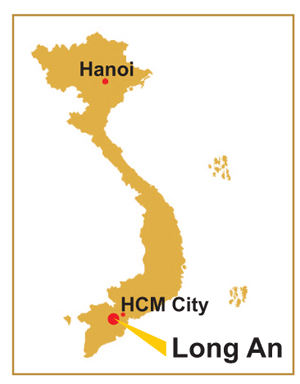(No.5, Vol.7,Oct-Nov 2017 Vietnam Heritage Magazine)
.jpg)
.jpg)

.jpg)

In September, 2016 Tran Thai Company started the Lang Sen Tourism project which includes eco-tourism convalescence, and nature resource exploration services plus access to traditional culture and lifestyle of local people. “We plan to begin officially receiving tourists and guests in 2018” the representative of Lang Sen Wetland Reserve management said. Calling to Lang Sen Wetland Reserve management at 0902943594 for more information.
Lang Sen Wetland Reserve, Tan Hung District, Long An Province, a western neighbor of Ho Chi Minh City, was named the world’s 2,227th and Vietnam’s 7th Ramsar forest in 2015. Since then, this area that used to be dubbed a ‘Minimized Dong Thap Muoi wetland in Mekong Delta’ is getting more and more attention from the research community.
About 90 km from Tan An of Long An Province, the 5,000km2 Lang Sen conservation zone is representative of the marshy land around Mekong estuaries.
I had a very exciting exploration trip to this special place.
From Tan An, I followed National Highway 62, then turned to Road 79 which led through a paradise of lush green honey-myrtle forests, rice paddies and lotus bogs.
After about 35km, I reached Lang Sen. Coming out to meet me was Mr Ut, who had worked over 8 years in the conservation zone. He said, ‘There are new walking paths in the zone, but by using a boat you can experience its peculiarities better.’
I stepped onto the boat and the fun began. The canal led to the center of the conservation zone, a sea of lotuses swaying in the breeze. Suddenly a thick flock of birds soared up from a patch of lotuses, startling me, Mr Ut shouted, ‘The grey-headed purple swamphen!’
From that moment on, flocks of hoopoes and weavers began to fuss around and above us. His hands on the steering shaft, Mr Ut told us that Lang Sen Wetland Reserve has 86 fish species and 142 bird species, including rare ones such as sarus cranes, glossy ibises, giant barbs and giant catfish. The rich flora here is also very diverse, including 156 species, mostly the typical ones of Dong Thap Muoi such as honey-myrtle, madder, Vietnamese olive (trám xanh), duck-feet (Lasia spinosa Thwaites).
‘Lang Sen combines four ecosystems: swampy system, honey-myrtle forest system, seasonal flooded grassland system and forest-lined river system. It has four of the most prominent colonies of wild rice, spike rush, water lily and honey myrtle,’ Mr Ut shared.
He showed me the colonies one by one, all very wild and untouched. The wild rice intrigued me the most. Mr Ut said, the wild rice colony occupied about 40ha. Scientifically named oryza rufipogon, it is a wild species, which thrives during the big water season. During the flooding season each stem can grow up to 15cm a day to stay on top of the rising water, faster and stronger than even grass. The most amazing thing about this species is that unlike any other kind of rice, the grains ripen individually, not the whole ear at the same time, and the ripened grains fall into the water before dawn. So, to harvest wild rice, one has to come here before sunrise on a very light boat, equipped with only a bamboo lattice and two bamboo poles.
At dusk we came to the birds’ night refuge area. From faraway I could hear the deafening noise of thousands of birds calling each other to bed.
,,
,,

